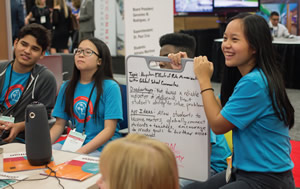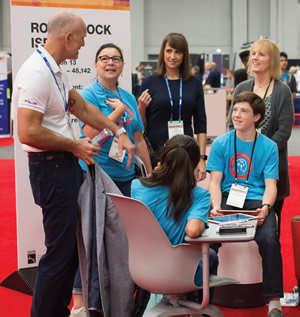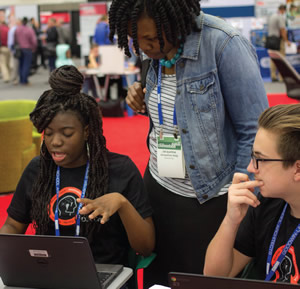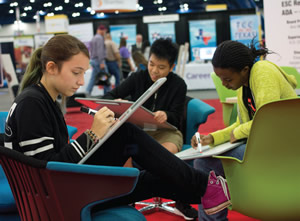Authentic Experiences
 Exploration and fun. Creativity and intuition. Collaboration and competition. All of these elements culminate in a celebration of learning known as the Student Innovation Challenge (SIC), which was first introduced by global design firm DLR Group at the 2015 National School Boards Association (NSBA)conference in Nashville. The SIC blends applied learning, collaboration, and teamwork, and is a learning exhibit that gives conference attendees a front row seat experience with modern pedagogy. It is a real-life, active learning exercise where students work alongside professionals and conventioneers to solve global and local problems. Since 2015, DLR Group has hosted 19 competitions in 14 states, collaborating with 63 school districts across the country to deliver this unique learning opportunity to national, state, and local education audiences.
Exploration and fun. Creativity and intuition. Collaboration and competition. All of these elements culminate in a celebration of learning known as the Student Innovation Challenge (SIC), which was first introduced by global design firm DLR Group at the 2015 National School Boards Association (NSBA)conference in Nashville. The SIC blends applied learning, collaboration, and teamwork, and is a learning exhibit that gives conference attendees a front row seat experience with modern pedagogy. It is a real-life, active learning exercise where students work alongside professionals and conventioneers to solve global and local problems. Since 2015, DLR Group has hosted 19 competitions in 14 states, collaborating with 63 school districts across the country to deliver this unique learning opportunity to national, state, and local education audiences.
To kick off the SIC, student teams develop a global problem statement prior to the live event, working with DLR Group experts to theorize potential steps to address the identified problem.
There are no restrictions on who students can invite for help, and some teams have connected with local business leaders, corporate CEOs, and university professionals for additional mentorship. As soon as they arrive at the conference, teams begin reaching out to conference attendees, asking for information to help them in their exercise or critique of their solution. A surprise twist is also introduced at the conference to ensure most of the thinking, designing, and creating occurs in collaboration with conference attendees. To conclude the event, student teams present their solutions during a conference session to hundreds of conference goers.
We recently sat down with DLR Group Principal Taryn Kinney (TK), and DLR Group Senior Associate Marilyn Denison, Ed.D. (MD), to discuss the SIC and how it elevates learning. We also talked with Dr. Jenny McGown (JM), deputy superintendent at Klein Independent School District (ISD) in Texas, and Kathleen Plott (KP), instructional officer of Advanced Academics for the Department of College and Career Pathways at Klein ISD, to learn more about how their experience at the SIC in 2017 prompted additional innovative learning activities within their district.

Student Innovation Challenge. The Student Innovation Challenge (SIC) was first introduced by DLR Group in Nashville at the 2015 NSBA conference. The SIC blends applied learning, collaboration, and teamwork, and is a learning exhibit that gives conference attendees a front row seat experience with modern pedagogy. It is a real-life, active learning exercise where students work alongside professionals and conventioneers to solve global and local problems. Since 2015, DLR Group has hosted 19 competitions in 14 states. Pictures in this article are from the 2017 and 2018 Texas Association of School Administrators/Texas Association of School Boards (TASA/TASB) Conventions in Austin, Texas.
Why did DLR Group initiate the SIC?
TK: DLR Group design teams often have the opportunity to see amazing, student-driven learning; however, we typically see this type of learning in isolated pockets, and not to the scale of an entire school district, city, or state. It is often initiated by a passionate teacher or school leader who challenges the status quo, takes a risk, invests the time to transition her own thinking or training as an educator, and trusts her learners with choices to drive engagement. Through the SIC, we’re offering conference attendees an in-depth look into the power of student-centered learning. Our goal is that this experience will spark new conversations in attendees’ home districts, and ultimately encourage a shift towards more authentic learning.
Describe the curriculum model used for the SIC.
MD: The curriculum model is a collaborative, hands-on framework called Challenge Based Learning, which is based on three action steps:
- Engage: Students use essential questioning to develop a personal and actionable challenge, such as a real-world problem that can be solved in their school or community.
- Investigate: Students develop conceptualized learning experiences and conduct rigorous, content- and concept-based research to create a foundation for the solutions they research.
- Act: Students explore their solutions in authentic settings, receive feedback, and learn from their successes and failures.
What do you personally observe during the SIC?
JM: The challenge is electric! The student, educator, and industry expert energy is high as everyone collaborates together to solve the problem. The element of competition also drives teams to push their out-of-the-box thinking, thoughtfully disrupt the status quo with their solutions, and fail forward throughout the design cycle.
MD: Students are having fun. By collaborating with students from other districts, as well as conference attendees, they experience real-time learning. Our ultimate goal is for students to be responsible for their own learning and to recognize they can use the natural resources around them when they return to their home districts.
TK: I am always amazed at how few physical supports are needed for in-depth learning to occur. Three items are key; technology, communication tools, and flexible furniture. Learners use devices to access resources, document findings, and communicate their ideas. Learners need an option to display or share information; therefore, white boards or other writable surfaces are always in high demand. The furniture must flex to their many postures, activities, and different group sizes during the day. Students are hungry for authentic information and experiences, and we provide the backdrop for this type of learning to occur.
 How do you define a successful SIC?
How do you define a successful SIC?
MD: I am inspired by what the students come up with, how energized they are to learn, and the friendships they build. If you give them the reigns, they produce. There is no test for the SIC; instead, we look for and support skills like teamwork, collaboration, communication, research, and creativity. Student teams prepare a presentation and experience speaking in front of a group of people they don’t know, which provides an opportunity to learn an important and necessary professional skill.
What is the takeaway for DLR Group?
TK: DLR Group begins each project with the end users in mind—learners and educators themselves. Our design teams spend time observing users in their current environment and engaging them in visioning workshops; however, we rarely get the opportunity to work directly with them for three consecutive days. The SIC affords us better access to the learning process itself. It is crucial for us to understand, at a deep level, what supports or tools students need as they move through the learning cycle. We ask a series of questions: “When do you need head-down focus time? How does the environment truly support that? When you collaborate, is the mobile furniture actually supporting that activity, or are you creating work-arounds to achieve the task at hand?” Each time we facilitate the SIC we gain more data to inform our design process. We are able to facilitate a divergent-thinking process that shifts our clients’ mind frame and allows them to make informed decisions about the future of learning and what they want learning to look like for their community.
Tell me about your SIC experience during the 2017 NSBA Conference in Denver.
KP: I agreed to participate in the SIC because of the innovative nature of the challenge. My entire career, I have worked with gifted and advanced learners and have found that project-based, performance-based learning is the epitome of critical and creative thinking. In Denver, our students experienced what has now become a national educational initiative: personalized learning in flexible environments. Student teams were able to work and think amongst flexible seating, atypical resource supplies (white boards, chart paper, building block seating), and participate in authentic applications of learning by questioning experts in the exhibitor showcase as well as pitch their ideas to superintendents and administrators from across the country.
After experiencing the SIC, Klein ISD embraced other innovative activities to engage learners. Describe those events.
KP: JASON Learning, a nonprofit that provides authentic science, technology, engineering, and math (STEM) learning experiences, invited Klein ISD to participate in another exercise shortly after our Houston community suffered devastation from Hurricane Harvey. The challenge was to design a prototype to keep a small house from flooding. In approximately six weeks, we drafted teams, created evaluation rubrics, conducted a Day of Design event, uploaded final products to an outside national evaluation team from STEM Connectors, and hosted a top ten final showcase. The response from students was phenomenal, with over 287 teams in grades K-12. During the Day of Design activity, kindergarten teams were placed next to students from high school teams, while sixth grade teams discussed their projects with third graders. The very demonstration of the benefits of multiage classroom research was evident as they collaborated seamlessly on their designs. Mentors from local businesses, including DLR Group, were also on hand. The winning team, comprised of four AP Physics students, are now continuing their research and design thinking skills in an independent research study class and have partnered with university professors as mentors.
Other challenges included KleinHacks, a student led “invention marathon” where students who were interested in technology built and shared their innovative products to solve a community problem. KleinTalks allowed students to exemplify the district’s “profile of a learner” through a TED Talks format, bringing humor and their own unique insight as they spoke about the importance of resilience and solutions to global problems, challenged preconceived notions, and demonstrated their artistic abilities. In the summer of 2018, students from across the district formed Culture4Caring, a student-led organization aimed at creating a more inclusive and welcoming environment within our district and our schools.
 In the fall of 2018, Klein ISD partnered with the Student Spaceflight Experiments Program (SSEP), which is a model U.S. National STEM Education initiative. Over 200 student teams conducted research, formed a hypothesis, designed an experiment, and created a technical writing proposal in hopes of having their experiment chosen. After a panel of experts reviewed more than 100 proposals, three teams were selected as finalists to go to SSEP for final judging. The winning team will watch their experiment launch to the International Space Station (ISS), and while aboard the ISS, astronauts will conduct experiments using the winning team’s instructions from the technical proposal.
In the fall of 2018, Klein ISD partnered with the Student Spaceflight Experiments Program (SSEP), which is a model U.S. National STEM Education initiative. Over 200 student teams conducted research, formed a hypothesis, designed an experiment, and created a technical writing proposal in hopes of having their experiment chosen. After a panel of experts reviewed more than 100 proposals, three teams were selected as finalists to go to SSEP for final judging. The winning team will watch their experiment launch to the International Space Station (ISS), and while aboard the ISS, astronauts will conduct experiments using the winning team’s instructions from the technical proposal.
How do community partners contribute to learning?
JM: Business and community partners are able to bring their expertise to the design table during a challenge. Whether visiting with students in person on Day of Design or engaging with them via Skype or Google Hangout throughout the challenge, these experts play a critical role not only in teaching students technical skills but also the soft skills necessary to successfully pitch an idea and collaborate and network with others.
What advice would you give an educator or administrator who would like to introduce authentic learning in their district?
KP: To an administrator pondering innovation, design thinking, and personalization, I would say take the risk. Rely on your best talent, find solutions based on the need of the learners and your community, and watch the joy of learning manifest.
We’ve discussed several authentic challenges Klein ISD has hosted or participated in. From your experience, what is the key to engaging students in learning?
JM: The key to engaging students in learning is to capitalize on their unique passions, talents, and interests and connect them with supportive, positive adults who have high expectations. When you design learning experiences that honor these two components—student interest and positive relationships—students engage in and own their learning authentically. Our innovative exercises and the SIC are excellent ways to ignite student engagement through the design process.
This article originally appeared in the School Planning & Management March 2019 issue of Spaces4Learning.